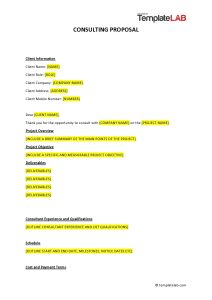How to Write a Business Proposal for Software
A business proposal is a short document that outlines what a software development company will do to address customer needs. It should use lay language and avoid software engineering jargon.
It should include a table of contents and the client’s contact information. A proposal should also be on-brand to ensure a seamless client experience.
Scope of work
The scope of work (SOW) section identifies what your software company is contracted to do for a client. It is important to concisely describe project objectives in this section and provide a detailed timeline for when these goals should be completed. This information will help your potential clients evaluate whether or not you are the right fit for their business. It will also help them understand how your services will benefit their customers and increase revenue.
The introduction of your business proposal should summarize the scope of the project. This can be done with a benefits-focused executive summary or a brief paragraph outlining the main objectives of the software solution you’re proposing. To build credibility, include case studies or testimonials from previous clients that prove your software is a good fit for their business needs.
Your table of contents helps readers keep track of where they are in the proposal software, which is especially helpful if your document is lengthy. It can be used to provide small summaries of each section or it can serve as a navigation tool. You can also add visuals to your proposal, including photos and videos that will catch the eye of prospective clients. Including multimedia in your proposals has been proven to boost your closing rates by 23%. Using a software like Ignition, you can even incorporate a digital brochure into your proposal to make the experience seamless for the client.

Pricing
If you’re going to write a business proposal for software, you need to make sure that the price is right. You don’t want to scare away the client or undersell yourself. However, you also don’t want to oversell yourself either. You’ll want to include a pricing comparison table in your proposal so that clients can see which product fits their budget best.
Your business proposal should start with an executive summary, which explains the key points of your offer and why you’re the best choice for the project. This section should be short and to the point, but it must be persuasive enough to convince a potential customer to invest their time and money in your solution.
In the next sections, you’ll get into more detail about the project. You’ll describe the steps you’ll take to solve your client’s problem, including what work will be done and how long it will take. You can also include an optional pricing table to help the client find the best fit for their business.
Finally, you’ll explain the legal aspects of your proposal. You can include these in the Terms and Conditions section or in a separate document. It’s important to keep in mind that your prospects are busy, so they don’t have a lot of time to read your proposal. Keep the content short and concise, and use clear wording.
Requirements
A business proposal is an important tool to help your clients understand what software solution best fits their needs. It should include a title page, table of contents, details on your company’s “why” in the executive summary, a problem or need statement, a proposed solution, qualifications, a timeline, pricing, billing, legal information, and an acceptance section where the client can sign the document.
The first thing a potential client will see is the title page, which should catch their attention and explain what the proposal is about. It is a good idea to use a powerful headline, such as “Your solution to X.” This will give the reader an idea of what they will read in the rest of the proposal.
In the problem or need statement, you should describe what the client is trying to accomplish and how your software can help them get there. You should also mention any other software solutions that could address the same issue, and explain why yours is better.
This section should focus on the benefits of your product, rather than the nitty-gritty details of software engineering or programming. This is because your potential clients are more interested in the bigger picture and how your software will impact their business. If you want to make this section more compelling, add social proof, such as testimonials from other clients or case studies that show the results of using your software.
Schedule
After explaining your software’s capabilities in the executive summary, you can go into more detail on how you plan to address the client’s problems in the proposal pages. This is where you can also include a timeline, which will help the client understand how quickly you can deliver on your promises.
In this section, you should describe the team members and their roles in your project. You should also provide a breakdown of costs and estimated completion dates. This will give the client a clear picture of what to expect, and it will help them make an informed decision.
If you’re using a cloud-based business proposal template, you can include images and videos to make your software proposal more compelling. This will help you increase your closing rates and win more clients. You can also use e-signatures and dynamic fee tables to boost your software proposals.
Business proposals vary slightly in style, but there are a few crucial elements that every one should contain. These elements include a title page, table of contents, cover letter, and executive summary. It’s also important to have an easy-to-read layout and clear language. Lastly, the proposal should include a way for the client to contact you. You should also include a disclaimer and confidentiality agreement. If you’re unsure of how to write a software business proposal, check out Growthink’s Ultimate Business Plan Template.